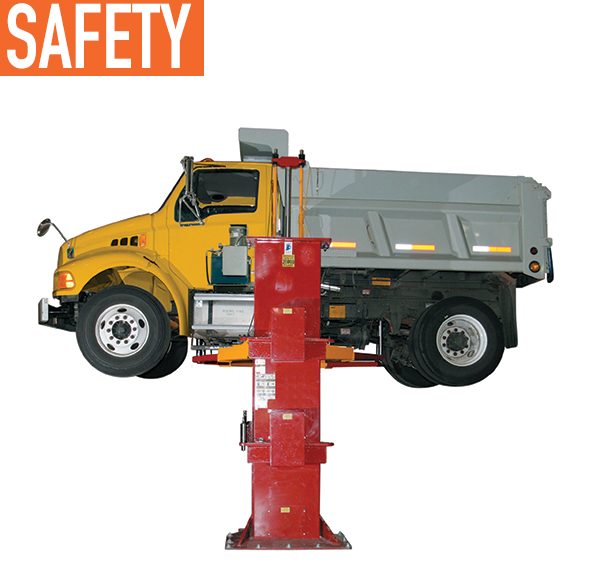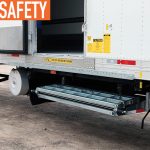Afleet manager’s responsibilities range from running the shop, dealing with HR or procurement issues, managing the budget, and—without question—running a shop where all technicians go home unharmed every night. Vehicle service lifts are some of the most productive pieces of shop equipment. As the shop director, you have responsibilities to your shop, customers, and employees to run the safest shop possible. To ensure safety, maintenance staff should adhere to a special set of rules and regulations when operating vehicle lifts.
STEPS TO SAFETY
Any fleet director who has ever had to go through an OSHA interview after a reported incident knows there are three basic questions: What did you know? When did you know it? What did you do about it?
In the event of an incident in your shop, the OSHA interview is the last thing to look forward to, but being proactive about lift safety will likely keep you from OSHA interrogation. The American National Standards Institute (ANSI) is the organization that writes the rules and regulations that OSHA uses to investigate compliance. It is important that maintenance staff operate under ANSI guidelines.
Below is a list of the most commonly overlooked safety items relating to vehicle lifts:
Inspect your vehicle lifts. ANSI regulations state that vehicle lifts are to be inspected annually by an experienced lift inspector. If a fleet director isn’t inspecting lifts annually, they are ignoring ANSI code, which may result in OSHA fines. Given the differences in lift brands, contact your lift supplier or visit autolift.org for a list of local and experienced Automotive Lift Institute inspectors in your area.
Train your technicians. If you ask an experienced tech, “When was the last time you were trained how to use a vehicle lift?” you may get a laugh. Experienced techs have used lifts for years and aren’t likely to believe they need training. Reference ANSI code, which is followed up by OSHA laws, and if upon an OSHA inspection there are no records of tech training, you leave your shop open to an OSHA citation.
What could be worse is sitting down to answer the three OSHA questions asked if an incident were to occur in the garage. Any bad answer paints your fleet into a corner. To shift the responsibility of lift training, an online training course is available for your technicians at autolift.org. After the tests are taken by your techs, permanent records remain on file with the Automotive Lift Institute.
Purchase certified lifts and certified options.
Lifts and options are manufactured to the ANSI/ALI ALCTV standard. Certification takes place at the manufacturer’s level, with the certification done by a nationally recognized testing lab to the ANSI/ALI ALCTV standard. This is important to your shop techs and fleet safety record. Not all lifts or options are certified. For example, every two-post lift needs truck adaptors on the swing arms to make contact with the vehicle frame. Yet not every two-post lift offers certified truck adaptors. Likewise, many mobile column lift manufacturers offer options to raise certain vehicles. However, if the certified capacity is lower than the weight of the vehicle you intend to service, you’ll find yourself using a noncertified option. Per the website of the Automotive Lift Institute, “Use of a noncertified accessory or option used on a certified lift voids the certification of the lift.” As a safety conscious fleet director, you don’t want to circumvent the one and only nationally recognized vehicle lift safety standard.
Don’t overload your lifts. As two-post lifts are the most common type of lift, operators should look at the safety decal that comes attached to them. By example, if your work truck weighs 11,000 lbs but the rear axle weight is 8,000, then the two rear swing arms are each lifting 4,000 lbs. You might think an 11,000-lb truck serviced on a 12,000-lb-rated lift is adequate, but when considering that the Automotive Lift Institute’s “Lifting It Right” publication states, “Do not overload the swing arms,” you’ll understand why your shop needs the properly rated lift for the job. Using the above example of an 8,000-lb rear weight, you need a 16,000-lb+ capacity lift.
Always lower lifts onto the mechanical locks. As a teenager you heard, “Never use a car jack without also using a safety jack stand.” Using a vehicle lift without lowering it onto the locks is the same. Additionally, some lift manufacturers offer a weight gauge. The most important aspect of a weight gauge is the visual safety confirmation that the tech has lowered the lift onto the locks. If not, the weight gauge displays the weight of the vehicle serviced. Are your techs lowering the lifts onto the locks? Do you need a visual indicator to always walk by the lift and see the weight gauge reads 0 lbs and that the lift is lowered onto the locks?
Review safety information. All vehicle lifts are required to come with a certain set of safety and warning decals, a safety tips card, operators manual, and a lifting point guide. The lifting point guide is a booklet that covers the last 20 years of lifting points for every passenger car and medium-duty truck on the road. As a “best practice,” if your five-year-old lift doesn’t have a current lifting point guide, get one (available from your local lift inspector or online at autolift.org). If your safety tips card (another required ANSI safety standard) is not prominent for the operator to see, move it.
Vehicle lift safety is an important part of operating your fleet. Safe lifts keep the shop productive, your technicians safe, and your fleet operational. Complying with the rules regarding vehicle lift safety is made simple when following the above guidelines or reviewing regulations on www.autolift.org.
ABOUT THE AUTHOR
Steve Perlstein is the president and government sales manager of Mohawk Lifts.
MODERN WORKTRUCK SOLUTIONS: JUNE 2018 ISSUE
Did you enjoy this article?
Subscribe to the FREE Digital Edition of Modern WorkTruck Solutions magazine.
![]()








